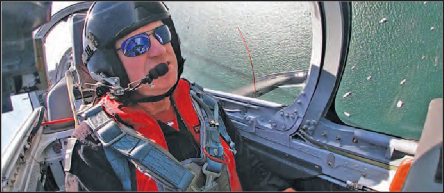Scott “Intake” Kartvedt: Solo Pilot Flying To Honor All Who Serve
By Jamie Mitchell
When Scott Kartvedt first saw the movie Top Gun, he was working as a professional accountant in Los Angeles. After watching the film one too many times, he called his local U.S. Navy recruiter, determined to find his own path to flying fighter jets off aircraft carriers. This ultimately led to a 21-year journey on active duty in the Navy, and one of the greatest adventures of Kartvedt’s life. In 1999, he joined the Blue Angels. Being part of this flight demonstration squadron meant more than wowing audiences during his 750 performances across the country. It also meant honoring the U.S. Navy Sailors and Marines who serve, an intention at the heart of every Blue Angel’s show. “The Blue Angels provided a lifetime of experiences,” Kartvedt says, reflecting on his three-year tour with the U.S. Navy squadron. “It was truly hum- bling to serve on the team representing 380,000 Sailors and 180,000 Marines.”
Kartvedt fondly remembers the F/A- 18, an “exceptional airplane with remark- able flight and combat capabilities,” which he spent more than 4,000 hours flying. He often flew as solo and opposing solo, per- forming technical flying outside of the traditional diamond formation. He recalls his favorite maneuver, the Fleur de lis, a six- plane burst guaranteed to amaze audiences with its precision, skill, and beauty. However, his favorite experience wasn’t a maneuver performed before the crowds, but rather, while hosting the Make-A-Wish foundation, which the Blue Angels did every Friday during practice shows. “The courage and guts those kids mustered in the face of adversity carried me through many arduous times – personally, professionally, and in battle,” he reminisces.
Recently for Scott “Intake” Kartvedt, life came full circle as a stunt pilot for the upcoming film, Top Gun: Maverick. (Courtesy Jamie Mitchell)
The knowledge and depth of skills Kartvedt gained from military duty opened doors to many opportunities. Most notably, being a member of the Patriots Jet Team, the largest civilian-owned aerobatic jet team in the western hemisphere. “The essential element to both teams is the trust and confidence you must have with your teammates,” he says of flying with the Blue Angels and the Patriots Jet Team. He emphasizes that trust and confidence are the deciding factors between “a high-risk endeavor with astronomical stress…or managed risk and a heck of a lot of fun.”
Flying has taught him many important lessons that he applies to all aspects of life, both on and off the ground. Kartvedt has learned the importance of saying yes to opportunity, and refusing to take no for an answer, regardless of how daunting the challenge may be. He has learned to embrace failure and learn from mistakes in order to overcome adversity and accelerate your success. And also, he has learned the power of asking: if you don’t risk asking, you will certainly miss out!
Recently for Kartvedt, life came full circle as he and Patriots Jet Team lead pilot, Randy Howell, were asked to be stunt pilots for the upcoming film, Top Gun: Maverick. Kartvedt realizes that if he didn’t say yes, embrace past failures, and simply ask, his dream of one day flying in Top Gun would never have come to fruition. “Pursue your flying dream with passionate commitment,” he recommends. “Learning to fly was the hardest thing I have ever done, but I was able to achieve my dreams because I kept asking questions, applying myself with a positive attitude, embracing my failures, and always saying yes!”
Kartvedt credits much of his success to legends like Eugene Ely, Neil Armstrong, and John McCain, all of whom are known for pushing the envelope, and most of whom he had been fortunate enough to meet. Above all else, he cites joining the Navy as the biggest turning point leading to his storied aviation career. “The camaraderie of the team is one of life’s sweet joys and team flying is incredible,” Kartvedt says. “But supporting American and coalition troops on the ground, which I had the honor to do during five deployments, is why I joined the service.”

